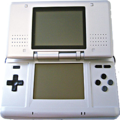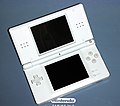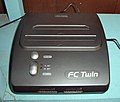Seventh generation of video game consoles
| Part of a series on the |
| History of video games |
|---|
The seventh generation is the current era in the history of computer and video games that began on November 22, 2005 with the release of Microsoft's Xbox 360, and continued a year later with the release of Sony's PlayStation 3 on November 11 2006 in Japan, November 17 2006 in the United States, Canada, Hong Kong, and Taiwan, and Nintendo's Wii on November 19, 2006 in North America and South America. European sales of the PlayStation 3 commenced on March 23 2007.
Home systems
Having only just formally begun, it is not yet possible to determine which, if any, of the three major consoles will dominate this generation. The Xbox 360 by Microsoft has gained an early lead in terms of market share, due in large part to its launch which came a year before its rivals. Sales figures in North America and Europe have continued to be strong, despite the launch of other consoles within the same period. Like its predecessor, the Xbox 360 has struggled in Japan due to a lack of RPGs, and the poor reception of some Japanese developed games, such as Ninety-Nine Nights and Every Party; however, the system's form factor has been more generally appreciated and sales have increased in the region recently, due to the release of the highly anticipated Blue Dragon.
It is more difficult to assess whether Sony's PlayStation franchise will be successful in this generation. It has a comparatively higher price, and the PlayStation 3 was released roughly a year later than its direct competitor, the Xbox 360. The system's reliance on very new technology such as the Cell microprocessor and Blu-ray format have caused difficulties in manufacturing. Nonetheless, despite many initial setbacks and delays, Sony demonstrated the capabilities of the PlayStation 3 at Tokyo Game Show 2006, with 27 playable demos and numerous titles ready for launch. Its success or failure will ultimately be decided by whether or not players feel that the games are worth the higher price of the console.
Nintendo entered this generation with a new business plan with its Wii console. The plan is firstly to capture as many gamers as possible and a new market of 'non-gamers' (and lapsed gamers) through new game play experiences and new forms of interaction with games. If the new market grows sufficiently large, Nintendo hopes that the new control aspect will render current conventionally controlled consoles obsolete, leading to Nintendo capturing a large portion of the existing market as well.[1]
Comparison
| Console | Xbox 360 | PlayStation 3 | Wii |
|---|---|---|---|
| Image | 
|

|

|
| Launch Price | USD$299.99 Euro €299.99 GBP £209.99 (Core) USD$399.99 Euro €399.99 GBP £279.99 (Premium) USD$479.99 (Elite) |
USD$499.99 (20 GB) USD$599.99 / Euro €599.99 / GBP £424.99 (60 GB) |
USD$249.99 / GBP £179.99 / Euro €249.99 |
| Top-selling Game | Gears of War | MotorStorm | Wii Sports (Pack-in expect Japan) The Legend of Zelda: Twilight Princess |
| Release Date | | | Template:Country data World More... |
Template:Country data World More... |
Template:Country data World More... |
| Included accessories and extras |
|
|
|
| Accessories (retail) |
|||
| CPU | 3.2 GHz IBM PowerPC tri-core codenamed "Xenon" | Cell Broadband Engine (3.2 GHz POWER-based PPE with seven 3.2 GHz SPEs) | 729 MHz PowerPC based IBM "Broadway"[3] |
| Memory |
512 MB GDDR3 @ 700 MHz shared between CPU & GPU, 10 MB EDRAM GPU frame buffer memory |
256 MB XDR @ 3,2 GHz, 256 MB GDDR3 @ 650 MHz, GPU can access CPU memory. |
24 MB "internal" 1T-SRAM integrated into graphics package, 64 MB "external" GDDR3 SDRAM, 3 MB GPU frame buffer memory |
| GPU | 500 MHz codenamed "Xenos" (ATI custom design) | 500 MHz RSX (based on NVIDIA G70 architecture) | 243 MHz ATI "Hollywood" |
| Controller |
Xbox 360 Controller (up to 4 wireless or 3 wired) |
SIXAXIS Controller (up to 7 via Bluetooth) PSP via Wi-Fi* or USB |
|
| Dimensions |
8.3 cm × 30.9 cm × 25.8 cm (6,616.9 cubic cm) |
9.8 cm × 32.5 cm × 27.4 cm (approx.) (8,726.9 cubic cm)[4] |
Approx. 5 cm × 11.5 cm × 21 cm (1,207.5 cubic cm) |
| Weight |
3.5 kg (7.7 lbs)[5] |
||
| Online service | (Extra charges apply) Xbox Live Live Arcade Points based store Webcam, headset Xbox Live Video |
PlayStation Network Arcade Currency based store Internet browser Webcam (including PlayStation 2 EyeToy), headset, PlayStation Home™ |
Nintendo Wi-Fi Connection WiiConnect24 Virtual Console Opera Browser |
| Backward compatibility | Selected Xbox games, additions made with software updates, Hard Drive required. | Most Playstation 2 titles; Most original Playstation titles either from the original disc or downloaded from the Playstation Network; future firmware updates will provide more compatibility.[9]
European version offers limited compatibility.[10] |
Supports all GameCube software and most accessories. Progressive scan capable Gamecube games can be displayed at 480P if a component cable is used. Some games from previous systems prior to Nintendo GameCube are available for download via Wii shop. Nintendo 64, Sega systems, Super Nintendo (SNES), Nintendo Entertainment System (NES), TurboGrafx-16 and others are also available. Nintendo Gamecube games require a Gamecube controller and Gamecube memory card. Many downloaded games require the use only with a Wii Classic controller and/or a Nintendo Gamecube controller. |
| System software | Xbox 360 Dashboard | Cross Media Bar (XMB) | Wii Channels |
| System software features |
Audio file playback (non-DRM AAC, MP3, WMA) |
Operating Systems can be installed and run via a hypervisor
|
Audio file playback (MP3) |
| Consumer programmability | Development on PC with XNA Game Studio ($99/year subscription, and no binary distribution).[13] | Development on console via free Linux platform or PC. | No |
| Resolutions | HDTV-capable (480i, 576i, 480p, 720p, 1080i; 1080p added with fall 2006 firmware update) | HDTV-capable (480i, 576i, 480p, 720p, 1080i, 1080p) | HDTV/EDTV-compatible (480i, 576i, 480p) |
| Video output | RGB, VGA,[14] Component, S-Video, Composite, SCART, (HDMI 1.2 available on Elite model) | RGB, Component, S-Video, Composite, HDMI 1.3 | RGB, Component, S-Video, Composite, SCART,[15] D-Terminal[2] |
| Network | 100BASE-TX (100 Mbit/s)(Broadband Ethernet)Ethernet Optional 802.11a/b/g Wi-Fi |
1000BASE-T Ethernet Wi-Fi 802.11 b/g (built-in*, optional adapter**) |
Built-in Wi-Fi 802.11 b/g Optional Ethernet via USB 2.0 Adapter |
| Audio | 5.1 Dolby Digital, 5.1 WMA Pro, 5.1 DTS, 7.1 Dolby TrueHD | 5.1 Dolby Digital, 5.1 DTS*, 7.1 Dolby TrueHD
PS3 outputs all of these formats in PCM via HDMI cable only. |
Dolby Pro Logic II 5.1 surround, stereo sound and a Mono speaker is built into the controller. |
| I/O | 2.4 GHz radio Infrared for remote 2x Memory Card slots 3x USB 2.0 ports One Ethernet port |
Bluetooth 2.0 4x USB 2.0 ports One Ethernet port 1 Memory Stick slot Pro/Duo SD/mini SD Compact Flash PS(one and 2)memorycard adapter USB add-on using the PS3's USB 2.0 |
Bluetooth 2x USB 2.0 ports Four controller and two memory card ports (GameCube) 1 SD Card slot[16] |
| Media | 12x (65.6–132 Mbit/s) DVD, CD, HD DVD (Add-on, for movie use only, extra charges apply) | 2x BD-ROM (72 mbit/s), 8x DVD, 24x CD, 2x SACD | Proprietary DVD, Nintendo GameCube Game Disc, DVD-Video playback announced for Japan 2007[17] |
| Storage | Included* / Optional** detachable SATA upgradeable 20 GB or 120 GB hard drive, with 14 GB or 114 GB available to user. Xbox 360 memory cards USB mass storage (AV content) |
2.5" upgradeable SATA 20** / 60 GB* hard drive with 14 and 54 GB available to user respectively Memory Stick, SD, & Type I/II CompactFlash (60GB modell) USB mass storage |
512MB built-in flash memory SD card Nintendo GameCube Memory Cards USB mass storage |
- Worldwide sales standings
| Console | Units Sold | Units Shipped |
|---|---|---|
| Xbox 360 | 9.5 million+[18] | 10.4 Million (as of December 31 2006) |
| Wii | 5.924 million+[19][20][21][22][23] |
N/A |
| PlayStation 3 | 2.64 million +[24][25] |
3 million [26][27][28] |
Handheld systems
For video game handhelds, the seventh generation began roughly with the release of the Nintendo DS. This handheld was based on a design fundamentally different from the Game Boy and other video game systems. The Nintendo DS offered new modes of input over previous generations: a touch screen and a microphone. Around the same time, Sony released its first handheld, the PlayStation Portable, in Japan. Although released around the same time, the PlayStation Portable was marketed to a different audience from the Nintendo DS. Also in 2005 was the release of the Gizmondo from Tiger Telematics. However, the Gizmondo sold poorly and Tiger Telematics was forced into bankruptcy by February 2006; the Gizmondo was discontinued.
2005 and 2006, respectively, saw the release of the GP2X from Gamepark Holdings and the formal announcement of the XGP from GamePark. Both handhelds follow a completely different market strategy from either the Nintendo DS or the PlayStation Portable. They utilize a Linux-based operating system on an open-source architecture for emphasis on portable software emulation and homebrew games. The GP2X is a 2D handheld that focused on stored media content such as user-uploaded music and videos. The XGP will be a 3D handheld similar to the PlayStation Portable, designed for commercial games. It promises the same open-source Linux architecture, while also supporting Windows CE. The XGP will be a much more advanced handheld than the GP2X, offering the same stored-content features while integrating advanced live-content features such as T-DMB mobile television and Wi-Fi. The release of the XGP may spark renewed controversy over the two GamePark companies that split from the one mother company, GamePark, over disagreements about the successor to the GP32 handheld (which eventually became the two handhelds mentioned). The two handhelds mark South Korea's official entry into the seventh generation handheld market.
Gallery
-
Nintendo DS
2004-2006 -
Nintendo DS Lite
2006–Present -
PlayStation Portable
2005–Present
- Worldwide sales standings
| Console | Units Sold | Units Shipped | Release Date |
|---|---|---|---|
| Nintendo DS | 35.61 million (inc. 17.33m DS lite sales) as of January 25, 2007[29] | N/A | November 21, 2004 |
| PlayStation Portable | 11.21 million in United States and Japan only[30][31] | 24.70 million as of December 31st, 2006[32] | December 12, 2004 |
Note: First year of release is the first year of the system's worldwide availability.
Software franchises
The following are video game franchises established within the seventh generation.







